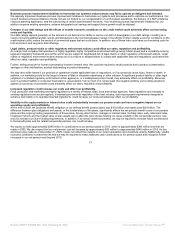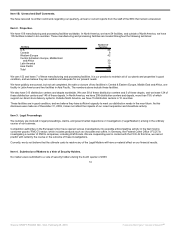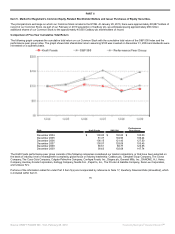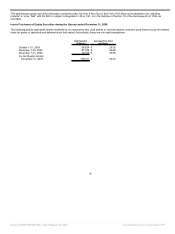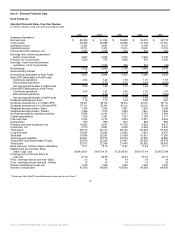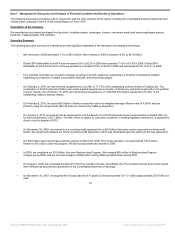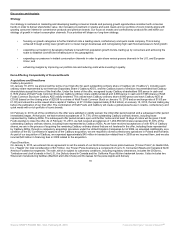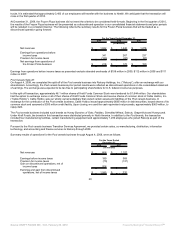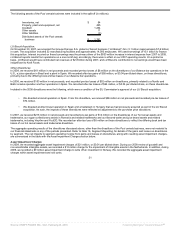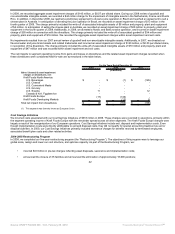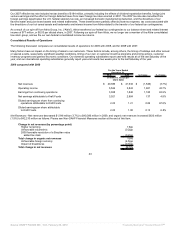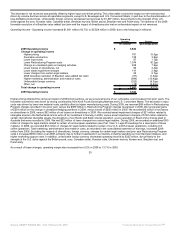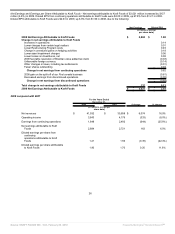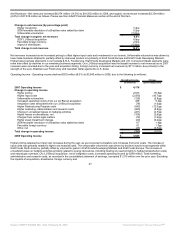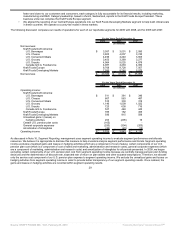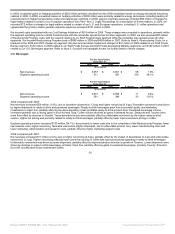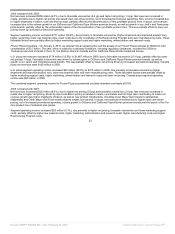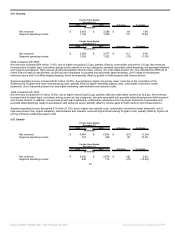Kraft 2009 Annual Report Download - page 26
Download and view the complete annual report
Please find page 26 of the 2009 Kraft annual report below. You can navigate through the pages in the report by either clicking on the pages listed below, or by using the keyword search tool below to find specific information within the annual report.
• will use cash to pay for $2.0 billion of the $3.0 billion in charges; and
• anticipate reaching cumulative annualized savings of $1.4 billion for the total program.
In 2009, we reversed $85 million of previously accrued Restructuring Program charges (resulting in a favorable impact to diluted EPS of $0.04).
Those reversals related to the following:
• We sold a plant in Spain that we previously announced we would close under our Restructuring Program. Accordingly, we reversed
$35 million in Restructuring Program charges, primarily related to severance, and recorded a $17 million loss on the divestiture of the
plant in 2009. The reversal occurred in our Kraft Foods Europe segment.
• We also reversed $50 million in Restructuring Program charges, primarily due to planned position eliminations that did not occur.
These were primarily the result of redeployment and natural attrition. The majority of these reversals occurred in our Kraft Foods
Europe segment, with the remainder spread across all other segments.
We incurred charges from continuing operations under the Restructuring Program of $989 million in 2008, or $0.45 per diluted share, and $447
million in 2007, or $0.19 per diluted share. Since the inception of the Restructuring Program, we have paid cash of $1.7 billion of the $2.0 billion in
expected cash payments, including $176 million paid in 2009. At December 31, 2009, we had an accrual of $270 million, and we had eliminated
approximately 17,300 positions under the Restructuring Program.
In 2008, we implemented a new operating structure built on three core elements: business units, shared services that leverage the scale of our
global portfolio, and a streamlined corporate staff. Within the new structure, business units now have full P&L accountability and are staffed
accordingly. This also ensures that we are putting our resources closer to where we make decisions that affect our consumers and customers. Our
corporate and shared service functions streamlined their organizations to focus on core activities that can more efficiently support the goals of the
business units. The intent was to simplify, streamline and increase accountability, with the ultimate goal of generating reliable growth for Kraft
Foods. In total, we eliminated approximately 1,400 positions as we streamlined our headquarter functions.
Under the Restructuring Program, we recorded asset impairment and exit costs from continuing operations of $884 million in 2008 and $320
million in 2007. We recorded implementation costs from continuing operations of $105 million in 2008 and $127 million in 2007. Implementation
costs are directly attributable to exit and disposal costs; however, they do not qualify for treatment as exit or disposal costs under guidance related
to accounting for costs associated with exit or disposal activities. These costs primarily include the discontinuance of certain product lines,
incremental expenses related to the closure of facilities and the reorganization of our European operations discussed below. Management
believes the disclosure of implementation charges provides readers of our financial statements greater transparency to the total costs of our
Restructuring Program. Refer to Note 6, Restructuring Costs, for details of our Restructuring Program by segment.
Provision for Income Taxes
Our effective tax rate was 29.4% in 2009, 29.0% in 2008 and 30.2% in 2007. Our 2009 effective tax included net tax benefits of $225 million,
primarily due to an agreement we reached with the IRS on specific matters related to years 2000 through 2003, settlements with various foreign
and state tax authorities, the expiration of the statutes of limitations in various jurisdictions and the divestiture of our Balance bar operations in the
U.S.
Our 2008 effective tax rate included net tax benefits of $222 million from discrete tax events. Of the total net tax benefits, approximately $50
million related to fourth quarter corrections of state, federal and foreign tax liabilities and a third quarter reconciliation of our inventory of deferred
tax items that resulted in a write-down of our net deferred tax liabilities. The remaining net tax benefits primarily related to the resolution of various
tax audits and the expiration of statutes of limitations in various jurisdictions. Other discrete tax benefits included the impact from divestitures of a
Nordic and Baltic snacks operation and several operations in Spain and the tax benefit from impairment charges taken in 2008. In addition, the
2008 tax rate benefited from foreign earnings taxed below the U.S. federal statutory tax rate and from the expected tax benefit of 2008
restructuring expenses. These benefits were only partially offset by state tax expense and certain foreign tax costs.
23
Source: KRAFT FOODS INC, 10-K, February 25, 2010 Powered by Morningstar® Document Research℠


